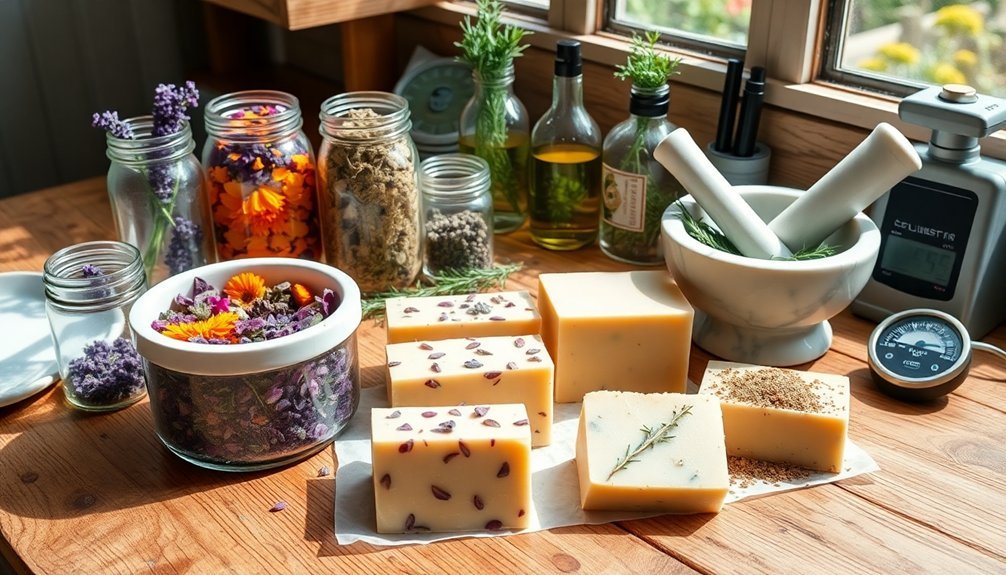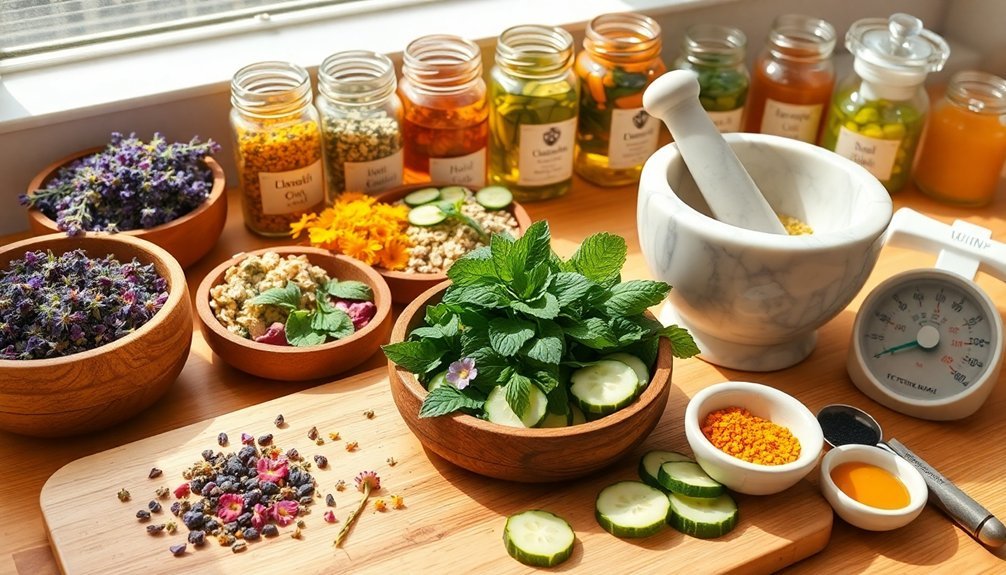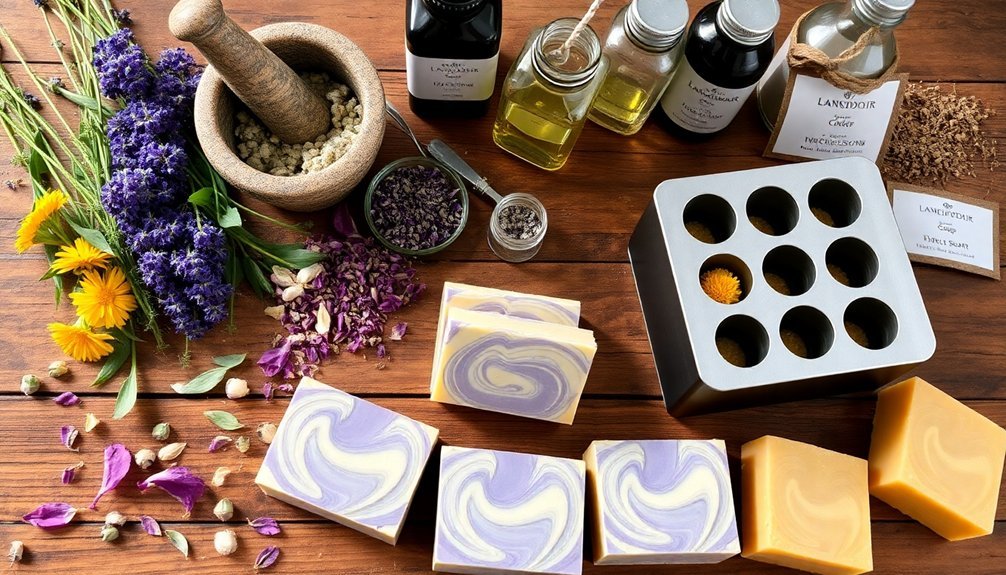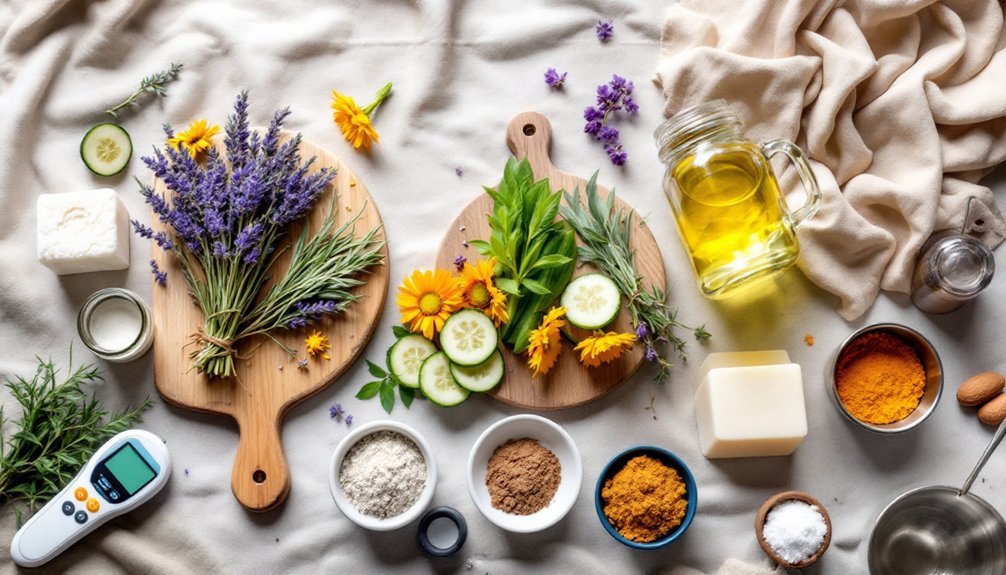When making plant-infused soaps, you'll need to dry herbs properly, use ½-1 teaspoon per pound of soap, and always wear protective gear when handling lye. Infuse oils with dried botanicals for 2-6 weeks to extract beneficial properties, and remember that most flowers discolor except calendula. Fresh herbs should be finely chopped or pureed to prevent mold. With the right techniques, your handcrafted botanical soaps will showcase your professional artisanship and deliver therapeutic benefits.
Safe Soapmaking: Using Plant Ingredients Like A Pro

While traditional soapmaking already transforms simple ingredients into luxurious bars, incorporating plant materials elevates your creations to new heights.
Start by infusing oils with dried herbs rather than fresh ones to prevent mold and extract therapeutic qualities effectively.
When adding visual elements, remember that most dried flowers discolor during the soapmaking process, with calendula flower petals being a reliable exception that maintains its vibrant appearance.
For best results, pulse dried herbs finely and use just ½-1 teaspoon per pound of soap to avoid dark speckles.
Experiment with herbal powders like chamomile for unique textures and colors, but monitor how they change during curing.
Always conduct a safety assessment before introducing new plant ingredients, as some herbs have regulatory usage limits in skincare products.
Essential oils provide another dimension of natural benefits when properly measured.
Essential Safety Protocols for Botanical Soap Making
Because handcrafting soap involves powerful chemicals alongside delicate botanicals, proper safety measures aren't optional—they're crucial. Always wear protective gloves and goggles when handling lye (sodium hydroxide) to prevent chemical burns. You'll need to work in a well-ventilated area to avoid inhaling harmful fumes.
| Safety Protocol | Purpose | Required Equipment |
|---|---|---|
| Physical Protection | Prevent skin/eye burns | Protective gloves, goggles |
| Ventilation | Avoid fume inhalation | Fan, open windows |
| Accurate Measurement | Guarantee safe formulations | Digital scale |
| Material Quality | Create safe products | Pesticide-free plant materials |
| Emergency Preparedness | Neutralize accidents | Vinegar bottle nearby |
Remember to accurately measure all ingredients with a digital scale—incorrect lye amounts can create unsafe soap. Always verify your plant materials are free from pesticides before incorporating them into your recipes.
Selecting and Preparing Plant Additives for Optimal Results

Selecting the right botanical ingredients for your soap requires careful consideration of both their beneficial properties and physical characteristics. Choose dried herbs over fresh whenever possible, using 1/2 to 1 teaspoon per pound of soap for best results.
When using fresh herbs, cut them into smaller pieces or puree them to minimize moisture and reduce spoilage risks.
For maximum potency, infuse oils with your chosen botanicals for 2-6 weeks before soap making. This extracts beneficial properties while preventing discoloration that occurs when mixing dried flowers directly into soap batter. Instead, reserve these as decorative elements to add after curing.
Store all plant additives properly and use within six months to maintain their effectiveness. Remember that dried flowers especially may lose vibrancy over time due to moisture absorption.
Understanding How Plant Properties Affect Saponification
Once you've gathered your plant ingredients, it's important to understand how they interact with the chemical process at the heart of soapmaking. Different plants alter the saponification process through their unique fatty acid profiles, directly impacting your lye-to-oil ratio calculations.
| Plant Ingredient | SAP Value | Effect on Formulation |
|---|---|---|
| Olive Oil | 0.134 | Mild, moisturizing |
| Coconut Oil | 0.190 | Hard, cleansing |
| Fresh Herbs | Varies | Adds moisture, nutrients |
| Natural Colorants | N/A | Visual appeal, may alter pH |
When incorporating plant-based exfoliants like oatmeal or dried lavender, you'll need to adjust your base formula to maintain proper saponification. Remember that fresh ingredients introduce additional moisture that can affect your soap's texture and shelf life. The beneficial properties of plant additives must be carefully balanced within your overall formulation to guarantee successful saponification without compromising your soap's quality.
Best Practices for Incorporating Herbs and Flowers Into Soap

While herbs and flowers can transform ordinary soap into botanical works of art, they require careful handling to maintain their beneficial properties.
When incorporating herbs, stick to 1/2 to 1 teaspoon of dried herbs per pound of soap to achieve visual appeal without overwhelming your creation.
Fresh herbs present challenges due to their high moisture content—puree or finely chop them to prevent mold and spoilage. For best results, consider infusing oils with dried herbs beforehand to enhance both color and therapeutic properties.
Be selective with flower choices as most turn brown in soap batter. Calendula stands out as an exception, maintaining its vibrant color throughout the process.
For a professional finish, attach larger dried flowers to cured soap using witch hazel, which helps them adhere without compromising soap quality.
Frequently Asked Questions
How Do You Make Soap Without Harmful Chemicals?
You'll make chemical-free soap by using plant-based oils like olive or coconut, handling lye safely with protective gear, adding essential oils for fragrance, following cold process methods, and coloring with natural ingredients like spirulina.
What Is the Healthiest Soap Base?
The healthiest soap base includes plant-based oils like olive, coconut, and sunflower. You'll benefit from these oils' nourishing properties while avoiding harsh chemicals. Organic ingredients guarantee your soap's free from pesticides and harmful additives.
How to Make Vegan Friendly Soap?
To make vegan-friendly soap, you'll need to use plant oils like olive, coconut, or sunflower instead of animal fats. Calculate your lye carefully, add natural fragrances, and consider including dried herbs for texture.
Can You Make Soap From Plants?
Yes, you can make soap from plants. You'll need plant-based oils like olive or coconut, plus lye for saponification. Add herbs, flowers, or essential oils for scent and therapeutic benefits in your creation.
In Summary
You're now equipped to create botanical soaps safely and effectively. Remember, always wear your protective gear, choose quality plant materials, and understand how they'll interact with your soap base. Don't rush the process—precise measurements and proper curing times matter. With these skills, you'll craft beautiful, natural soaps that showcase the best of what plants have to offer. Happy soap making!





Leave a Reply